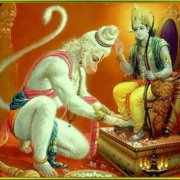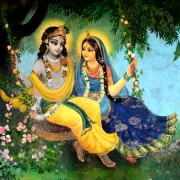Sraddha to Prema in the Holy Name
Mahanidhi Madan Gopal Das
In Bhajana-rahasya, the sequel to Harinama-cintamani, Srila Bhaktivinoda Thakura systematically describes how a devotee can attain kṛṣṇa-prema. He says the Hare Kṛṣṇa maha-mantra consists of sixteen names in eight pairs. Each pair corresponds to one sloka of the Siksastakam, and to one or more of the devotional stages beginning with sraddha and ending with prema.
Hare Kṛṣṇa: The first pair of names ‘Hare Kṛṣṇa’ signifies subduing ignorance and performing harinama with faith. Chanting the holy name with faith removes all ignorance and forgetfulness of Kṛṣṇa. This is expressed in the first verse of Siksastakam–ceto darpanan marjanam. (Sraddha)
Hare Kṛṣṇa: The second pair of names ‘Hare Kṛṣṇa’ means that Kṛṣṇa’s names have all the power and potencies (nija sarva sakti) found in His personal form. By faithfully chanting the holy name in the association of pure devotees one develops attachment for bhajana. Such hari bhajana will destroy most anarthas and bring one to the platform of firm faith and steadiness. This pair of names represents the second sloka of Siksastakam: namnam akari bahudha nija sarva saktis. (Sadhu-sanga, Bhajana-kriya, Anartha-nivrtti)
Kṛṣṇa Kṛṣṇa: The third pair of names ‘Kṛṣṇa Kṛṣṇa’ indicates association with pure devotees and being fixed in faith throughout the day and night. In other words, one must be pure in his sadhana and strictly avoid association with materialists, antagonists, Mayavadis and the opposite sex. This pair of names represents the third sloka of Siksastakam: trnad api sunicena. (Nistha)
Hare Hare: The fourth pair of names ‘Hare Hare’ awakens unmotivated devotion along with a taste for nāma-saṅkīrtana. By chanting with faith and steadiness one begins to savor the taste of nama. One then loses all attraction for maya as described in the fourth sloka of Siksastakam: na dhanam na janam na sundarim. (Nama-ruci)
Hare Rama: The fifth pair of names ‘Hare Rama’ signifies increasing taste for suddha bhakti and smarana, remembering Kṛṣṇa’s vraja lila. This stage of attachment to Kṛṣṇa is described in the fifth sloka of Siksastakam: ayi nanda tanuja kinkaram. (Asakti)
Hare Rama: The sixth pair of names ‘Hare Rāma’ indicates chanting with intensely divine emotions that dissipate all material desires and attach one firmly to Kṛṣṇa. This state is described in the sixth sloka of Siksastakam: nayanam galad asru dharaya. (Bhava)
Rama Rama: The seventh pair of names ‘Rāma Rāma’ awakens the mood of separation (vipralambha bhava) in the heart of a devotee, and a strong desire to attain the service of Radha-Govinda in vraja madhurya-rasa. Serving Kṛṣṇa in the mood of separation is shown in the seventh sloka of Siksastakam: yugayitam nimesena caksusa pravrsayitam. (Vipralambha-prema)
Hare Hare: With the eighth pair of names ‘Hare Hare’ suddha sattva appears to fill the sadhaka’s heart with gopi-bhava. Following the mood of the Vraja-gopis, one attains the goal of life–prema seva of Radha-Kṛṣṇa throughout the eight divisions of the day and night. This state of perfection is described in the last sloka of the Siksastaka: aslisya va pada-ratam pinastu mam. (Sambhoga-prema).
An excerpt from the book Art of Chanting







Leave a Reply
Want to join the discussion?Feel free to contribute!